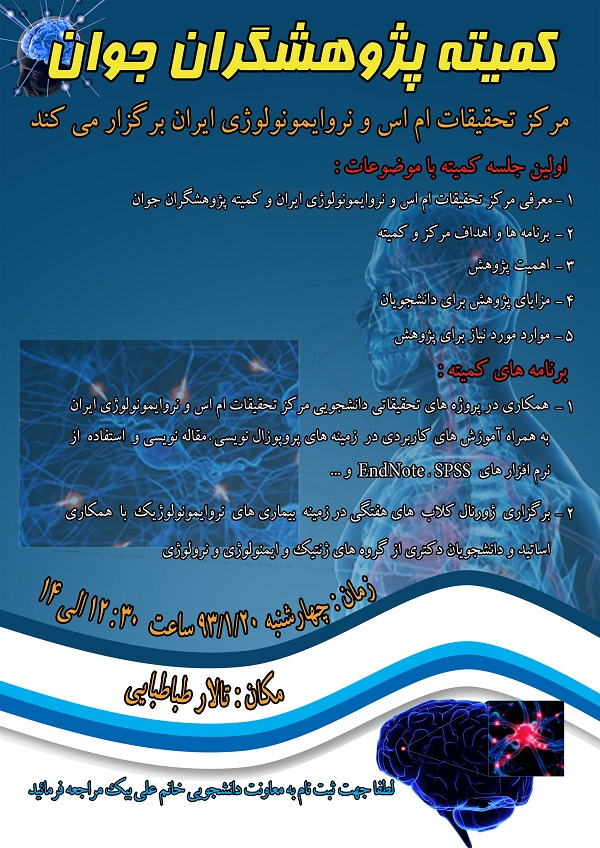روزانهها
همهپیوندها
- وزارت بهداشت ، درمان و آموزش پزشکی
- دانشگاه علوم پزشکی اصفهان
- مجله هنری فرهنگی ماه پاک
- دانشجویان پزشکی اصفهان مهر٩١
- پزشکی اصفهان مهر 92
- دانشجویان پزشکی ورودی92 جیرفت
- دانشجویان داروسازی 92 اصفهان
- نشریه به توان 5
- علمی، سرگرمی، تجوم همه چیز
- نکات آناتومی
- بسیج دانشکده پزشکی
- شورای مشاورین جوان
- سایت اطلاعات سلامت شهر اصفهان
دستهها
برگهها
جدیدترین یادداشتها
همهنویسندگان
- مدیر 41
- امیررضا منطقی نژاد 202
- رضا بختیاری مقدم 54
- سیاوش کریمی 4
- الهام یزدانی 21
- مهران منانی 36
- محمد مهدی صفری 18
- گروه جزوه نویسی 84
- Ehsan Adineh 101
- معین رضایی 4
- علی نبوی 2
- مهیلا یادگار 14
- علیرضا 15
- میلاد ارازی 12
- فهیمه بیکی 5
- خانم شریفی 12
- Mohammad Malakooti 8
- mahepak 1
- petros fadakar 17
- محمد امین مفلح 20
- صفورا عرفانیان 11
- میلاد صفری 1
- ابوالفضل اسماعیلی 16
- علی خسروپور 17
- الهه شگفت 97
- محمد هاتف 96
- مهدی وحیدیان 55
بایگانی
- شهریور 1395 1
- تیر 1395 5
- خرداد 1395 3
- اردیبهشت 1395 4
- فروردین 1395 3
- اسفند 1394 4
- بهمن 1394 1
- دی 1394 10
- آذر 1394 14
- آبان 1394 10
- مهر 1394 3
- شهریور 1394 9
- مرداد 1394 2
- تیر 1394 18
- خرداد 1394 45
- اردیبهشت 1394 49
- فروردین 1394 24
- اسفند 1393 31
- بهمن 1393 42
- دی 1393 73
- آذر 1393 89
- آبان 1393 66
- مهر 1393 55
- شهریور 1393 25
- مرداد 1393 20
- تیر 1393 33
- خرداد 1393 42
- اردیبهشت 1393 38
- فروردین 1393 21
- اسفند 1392 25
- بهمن 1392 25
- دی 1392 23
- آذر 1392 39
- آبان 1392 62
- مهر 1392 41
- شهریور 1392 10
تقویم
شهریور 1395| ش | ی | د | س | چ | پ | ج |
| 1 | 2 | 3 | 4 | 5 | ||
| 6 | 7 | 8 | 9 | 10 | 11 | 12 |
| 13 | 14 | 15 | 16 | 17 | 18 | 19 |
| 20 | 21 | 22 | 23 | 24 | 25 | 26 |
| 27 | 28 | 29 | 30 | 31 |
جستجو
اسلاید ایمنی
اسلاید اولین جلسه بعد از عید درس ایمنی
در ضمن همه اسلاید ها در دانلود سنتر و دفتر مجلات هست
فراخوان همکاری تیم اجرایی -دومین مدرسه تابستانی بین المللی سلامت عمومی ایران

دومین دوره مدرسه تابستانی بین المللی سلامت عمومی ایران (IPHS2014) در شهریور ماه 93 با همکاری دانشگاه علوم پزشکی اصفهان در شهر اصفهان برگزار می گردد. بدین وسیله از علاقمندان به همکاری با تیم اجرایی این مدرسه تابستانی دعوت می شود تا فرم همکاری تیم اجرایی به آدرس زیر را تکمیل نمایند.
پیش از تکمیل فرم حتما اطلاعات اولیه مربوط به تیم اجرایی را در لینک زیر مطالعه نمائید.
شما می توانید اطلاعات خود را ابتدا در پیش نویس همین فرم در لینک زیر وارد و سپس آن ها را به این فرم منتقل نمائید.
لطفا در وارد کردن اطلاعات دقت نمائید و فرم های خود را حداکثر تا تاریخ شنبه 16 فروردین 1393 ثبت نمائید.
13 به در
سلام
تبریک وتسلیت
این مطلب انگلیسی رو دوستان مسلط به این زبان خوب بخونن
بدرد می خوره
درباره جشن پوریم هست
Purim, ( (Hebrew:: “Lots”), ) English Feast of Lots, a joyous Jewish festival commemorating the survival of the Jews who, in the 5th century bc, were marked for death by their Persian rulers. The story is related in the Old Testament Book of Esther.
Haman, chief minister of King Ahasuerus, incensed that Mordecai, a Jew, held him in disdain and refused obeisance, convinced the King that the Jews living under Persian rule were rebellious and should be slaughtered. With the King’s consent, Haman set a date for the execution (the 13th day of the month of Adar) by casting lots and built a gallows for Mordecai.
When word of the planned massacre reached Esther, beloved Jewish queen of Ahasuerus and adopted daughter of Mordecai, she risked her life by going uninvited to the King to suggest a banquet that Haman would attend. At the meal she pleaded for the Jews and accused “this wicked Haman” of plotting the annihilation of her people. Upset, the King stepped out into the palace gardens. On returning, he found Haman “falling on the couch where Esther was.” The King mistook Haman’s frantic pleas for mercy as an attack upon the queen. The outraged King ordered that Haman be hanged and that Mordecai be named to his position. Esther and Mordecai then obtained a royal edict allowing Jews throughout the empire to attack their enemies on Adar 13. After an exhilarating victory they declared the following day a holiday and (alluding to the lots Haman had cast) named it Purim.
The historical reality of this biblical episode has often been questioned, and the actual origins of the Purim festival, which was already long established by the 2nd century ad, remain unknown. The ritual observance of Purim begins with a day of fasting, Taʿanit Esther (Fast of Esther) on Adar 13, the day preceding the actual holiday. The most distinctive aspect of the synagogue service is the reading of the Book of Esther. On Purim Jews are also enjoined to exchange gifts and make donations to the poor. Through the years many nonreligious customs have come to be associated with the festival, among them the baking of the three-cornered pastries called hamantaschen (“Haman’s ears”). Purim plays, which became popular during the 17th century, contribute to the carnival atmosphere especially enjoyed by children
اینم یه مطلب فارسی در این باره: لینک مطلب
